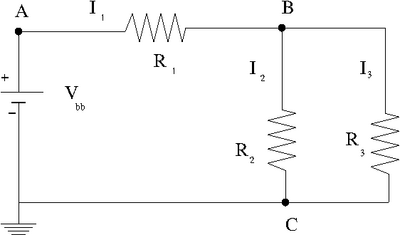Lab 1 TF EIM
Kirchoff's Law (50 pnts)
Smoky Circuits
When doing these labs it is important to determine the limitations of your electrical components in order to avoid damaging them
This lab uses resistors. Resistors are vulnerable to melting if you push too much current through them.
Resistors have power ratings ranging from 1/8 Watt up to several Watts. The common resistors are rated at 1/4 Watt. Let's assume this rating for the resistors in is lab.
Determine the maximum voltage of the DC power supply you will use. (ie, 30 Volts)
- By keeping your resistance values above 400 you should be able to avoid burning up 1/4 Watt resistors.
The next objective is to use resistors which allow currents that you can measure with your voltmeter.
- Since V=IR \Rightarrow I = V/R = 30 Volts/400 \Omega = 0.75 mA
Determine the range of currents which the voltmeter can measure. (ie 1 mA)
To get measurable currents you need low resistance BUT the lower resistances will need to have a high power rating. These two competing properties limit the range of resistances you can use.
Construct the circuit below.
Enter the values of the DC voltage and Resisters that you used.
Use a voltmeter to measure the potential difference and resistances.
| Variable | Measured Value |
Enter the measured and predicted quantities in the table below
Use Kirchoff's laws to predict the Voltage () and current values and compare them to your measurements by filling in the table below.
| Variable | Measured Value | Predicted Value | % Difference |
Internal resistance (30 pnts)
Measure the internal resistance of your power source by graphing the potential difference on the x-axis and the current on the y-axis for several values of the resistance shown in the circuit below. Begin with and then decrease it by a factor of 5 for each subsequent measurement. You can use a volt meter to measure the current and potential difference.
Questions (20 pnts)
- What conservation law is involved in Kirchoff's Loop Theorem?
- What does the slope in the internal resistance plot above represent?
